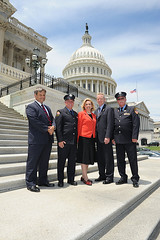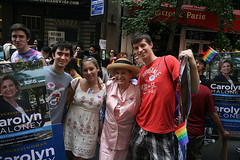 Congresswoman Carolyn B. Maloney, here greeting constituents at the India Day Parade last month, said that job creation is crucial for eliminating income inequality in the East Village.
Congresswoman Carolyn B. Maloney, here greeting constituents at the India Day Parade last month, said that job creation is crucial for eliminating income inequality in the East Village.Only days after Representative Carolyn B. Maloney won the Democratic party’s nomination for the 14th Congressional District, she was on her way to Washington to continue her long fight to pass the 9/11 Health and Compensation bill, of which she has been a leading advocate.
Ms. Maloney, 64, who defeated her opponent, Reshma Saujani, in the primary elections on Sept. 14 with 81 percent of the vote, spoke with The Local East Village about her stance on poverty, homelessness, noise violations – and bed bugs! – in our neighborhood.
The New York Times published a story last week focused on how the recession has raised poverty levels to a 15-year high. How does this relate to the East Village?
Now, there seems to be more of a need for homeless shelters and there is federal funding for the homeless that has come into New York City. Homeless shelters have to serve as a gateway to a home. Many of the homeless have multiple problems that require services. People need to be referred to a place that is most appropriate for their needs. Our communities need good social services. I find it troubling that the gap between the haves and the have-nots has grown.
The recovery has been better in New York than around the country. I think it’s a tremendous tribute to the resiliency of our city, of our ability to adjust and come forward with new ideas to help our economy.
How will you help small businesses in the East Village?
You need to narrow the gap between the haves and the have-nots by growing the economy, by providing jobs. Just this week, we are passing in the House a $30 billion loan program for small businesses so they can expand and hire more people. Small businesses employ 98 percent of the people in our country. Small businesses are complaining about a lack of equity; that bill will be out there to help.
How can the construction of the Second Avenue Subway help the neighborhood?
This is employing thousands of people in good-paying jobs. The Lexington Avenue line is the most overburdened subway line in the country. This will make life easier for commuters, business and schools. My goal is to build it to the tip of Manhattan. In terms of your questions about homeless shelters, which are related to whether or not people have jobs, this is a major job employer.
You don’t joke around with the bed bug problem in the East Village. What are you doing to help?
It has become a crisis. I’ve talked to exterminators and bed bugs are difficult to get rid of because they can hibernate for a year without blood. We need a federal response to help this city. The EPA advisory committee held a two-day conference on bed bugs, believe it or not. I have talked to constituents who did everything to get rid of them, and they can’t. They literally have to move.
I believe there was a law that just passed on the state level that landlords must tell tenants whether or not an apartment has been infested with bed bugs before they rent it to them and I think that’s a good law.
New York has an infestation problem now. We need to find more resources directed toward eradication, on the city, state, and federal levels. I don’t think it’s paranoia that you have bed bugs that you can’t get rid of; that’s a serious problem.
Many people in the East Village are concerned about the increase in bars in the neighborhood, and the noise levels. How can residents take action?
The community determines which ones are appropriate for their neighborhood. Some bring in business and have a unique attribute that helps the community. The community board votes on and recommends on issues related to liquor licenses, outdoor cafes, bars. If it’s an elegant, lovely restaurant with and outdoor café it might be an amenity that the community likes. Or, if it’s making a lot of noise and attracting a bad element, then the community may decide they don’t want it. It’s the voices of the community making these considerations. It could be a positive in some ways. Sometimes it adds to the flavor of the neighborhood; sometimes it’s a hindrance.
Where do you stand on the increasing number of high-rise apartment buildings in the East Village?
You can approach it by passing zoning that preserves the community, the low-level housing. That would be something that would go through the city council. Landmark individual buildings that are particularly beautiful and historic. Create a historic district, where you preserve the low-rise buildings. Landmarking is done on the community level. The community should form a neighborhood organization that looks at which buildings should be landmarked for historic importance and work on creating a historic district.
Why is architectural preservation important in the East Village?
Many residents have expressed their desire to maintain the lower-level buildings that are characteristic of the East Village. I am sympathetic to the desire to preserve the character of the neighborhood. This neighborhood is a very important one. It provides a window into America’s past. Lower Manhattan was the entry point for immigrants. There are many beautiful, old buildings that should be preserved. On the other hand, there are more modern high rises that were built to provide affordable housing. It’s a very eclectic neighborhood.
What buildings stand out to you?
One of the interesting buildings there is First Houses. It’s the first public housing ever built in the United States. It was built during the Great Depression and it has some beautiful work in it. It’s an important statement to the efforts we have made to provide affordable housing.
What intrigues you most about the communities in the East Village?
The diversity and combination of so many cultures. I was told there are 200 nationalities there. When you walk down the street, people are talking in Polish, Spanish, Ukrainian. There are people who are Jewish, Egyptian, Turkish. It’s like an international meeting place!
Do you have a favorite restaurant?
I really like the Ukrainian place, Veselka. And Katz’s Deli on Houston. Those are two good places. And I’ve been to some of the Indian restaurants on Sixth Street.
What’s next on your agenda?
I have a meeting with Luis CdeBaca, [the Ambassador-At-Large who was appointed by President Obama in 2009] who heads the combating of sex trafficking. I have a bill that would address sex trafficking of minors. We had a hearing on it last week. I’ve been talking to him about seeing if we can move it forward. There are reports from police and law enforcement that the number of sex-trafficked Americans is going up. We are doing a better job of patrolling our borders; they are not coming in from other countries. Sex trafficking, believe it or not, is a huge problem in our city. It’s a terrible situation.
Then I’m going to Washington and working to pass the 9/11 Health and Compensation bill. I am praying and crossing my fingers that we will finally pass the 9/11 Health and Compensation bill.





